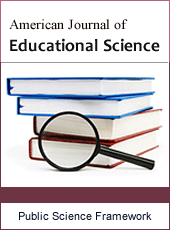American Journal of Educational Science
Articles Information
American Journal of Educational Science, Vol.4, No.4, Dec. 2018, Pub. Date: Aug. 31, 2018
Adapted Learning Environments for Future Education Systems
Pages: 100-114 Views: 2247 Downloads: 1353
[01]
Shimon Amar, President of College, Ohalo College of Education, Katzrin, Israel.
[02]
Netanel Bar David, Innovation Unit, Ohalo College of Education, Katzrin, Israel.
Today, teachers are expected to prepare their students to cope with the future, which, at this stage, is uncertain for both the students and the teachers. Scholars in the fields of education and occupational studies have identified a number of competencies that meet the needs of the 21st century and are required and essential for the success of a society, enterprise or any organizational unit. Therefore, educational institutions should provide their students at all levels with the ability to cope with situations which require these competencies. In this article we focus on action research regarding the work which has been conducted during the last four years mainly at the Teachers Training College and which aimed at suggesting new characteristics for learning environments at the educational institutions. Based on our previous work and experience in the field of learning and teaching, we will present a new perspective on the desired learning environment which includes the content, pedagogy and technology, as well as the interfaces among them. We will elaborate on the creation and usage of diverse and innovative learning spaces, aimed to reflect the contemporary reality in the 21st century places of employment and workplaces, and provide concrete examples of implementation of a pedagogical model in those spaces.
Learning Environment, Learning Spaces, Innovative Pedagogy, Interdisciplinary Teaching, 21st Century Skills
[01]
Amar, S., & Bar David, N. (2016). Realistic Intelligence and 21st Century Skills in Adapted Learning Environment. American Journal of Educational Research, 4 (8), 588-596.
[02]
Stuart, L., & Dahm, E. (1999). 21st century skills for 21st century jobs. Federal Publications, 151.
[03]
Trilling, B., & Fadel, C. (2012). 21st century skills: Learning for life in our times. John Wiley & Sons.
[04]
Ananiadou, K., & Claro, M. (2009). 21st century skills and competences for new millennium learners in OECD countries.
[05]
Collet, C., Hine, D., & du Plessis, K. (2015). Employability skills: perspectives from a knowledge-intensive industry. Education+ Training, 57 (5), 532-559.
[06]
Mishra, P., & Koehler, M. J. (2006). Technological pedagogical content knowledge: A framework for teacher knowledge. Teachers college record, 108 (6), 1017-1054.
[07]
Hooper, S., & Rieber, L. P. (1995). Teaching with technology. Teaching: Theory into practice, 2013, 154-170.
[08]
Jonassen, D., Mayes, T., & McAleese, R. (1993). A manifesto for a constructivist approach to uses of technology in higher education. In Designing environments for constructive learning (pp. 231-247). Springer, Berlin, Heidelberg.
[09]
Krathwohl, D. R. (2002). A revision of Bloom's taxonomy: An overview. Theory into practice, 41 (4), 212-218.
[10]
Collins, A., & Halverson, R. (2018). Rethinking education in the age of technology: The digital revolution and schooling in America. Teachers College Press.
[11]
Ackoff, R. L., & Greenberg, D. (2008). Turning Learning Right Side Up: Putting Education Back on Track (paperback). Pearson Prentice Hall.
[12]
Prince, M. (2004). Does active learning work? A review of the research. Journal of engineering education, 93 (3), 223-231.
[13]
Freeman, Scott, et al. "Active learning increases student performance in science, engineering, and mathematics." Proceedings of the National Academy of Sciences 111.23 (2014): 8410-8415.
[14]
Häkkinen, P., Järvelä, S., Mäkitalo-Siegl, K., Ahonen, A., Näykki, P., & Valtonen, T. (2017). Preparing teacher-students for twenty-first-century learning practices (PREP 21): a framework for enhancing collaborative problem-solving and strategic learning skills. Teachers and Teaching, 23 (1), 25-41.
[15]
Coley, R., Cradler, J., & Engel, P. K. (1997). Computers and Classrooms: The Status of Technology in US Schools. Policy Information Report.
[16]
Casey, D. M. (2008). The historical development of distance education through technology. TechTrends, 52 (2), 45-51.
[17]
Commission of The European Communities (2003). Implementation of the "Education & Training 2010" programme. Retrieved from: http://aei.pitt.edu/42882/1/SEC_(2003)_1250.pdf
[18]
Hew, K. F., & Brush, T. (2007). Integrating technology into K-12 teaching and learning: Current knowledge gaps and recommendations for future research. Educational technology research and development, 55 (3), 223-252.
[19]
Howard, S. K. (2013). Risk-aversion: Understanding teachers’ resistance to technology integration. Technology, Pedagogy and Education, 22 (3), 357-372.
[20]
Yadav, A., Hong, H., & Stephenson, C. (2016). Computational thinking for all: pedagogical approaches to embedding 21st century problem solving in K-12 classrooms. TechTrends, 60 (6), 565-568.
[21]
Mulcahy, D., Cleveland, B., & Aberton, H. (2015). Learning spaces and pedagogic change: envisioned, enacted and experienced. Pedagogy, Culture & Society, 23 (4), 575-595.
[22]
Nissim, Y., Weissblueth, E., Scott-Webber, L., & Amar, S. (2016). The Effect of a Stimulating Learning Environment on Pre-Service Teachers’ Motivation and 21st Century Skills. Journal of Education and Learning, 5 (3), 29.

ISSN Print: 2381-7127
ISSN Online: 2381-7135
Current Issue:
Vol. 6, Issue 2, June Submit a Manuscript Join Editorial Board Join Reviewer Team
ISSN Online: 2381-7135
Current Issue:
Vol. 6, Issue 2, June Submit a Manuscript Join Editorial Board Join Reviewer Team
| About This Journal |
| All Issues |
| Open Access |
| Indexing |
| Payment Information |
| Author Guidelines |
| Review Process |
| Publication Ethics |
| Editorial Board |
| Peer Reviewers |


